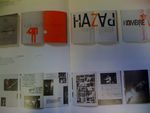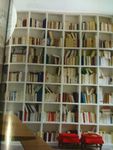Grids and dictionary
Notes from the introduction of Lucienne Roberts in GRIDS, Creative Solutions for Graphic Designers
From the beginning of printing until the Industrial Revolution, the book was the primary output of printing. Apart from verse, type was generally set in one justified column per page, placed symmetrically on the spread with larger outer margins than inners, and a larger margin at the foot than at the head. The proportions of the pages and margins were determined by geometry. The golden section is recognised as the most successful ratio to produce beautiful pages: the relationship of short to long side of a golden rectangle is 1:1.618. Adding two numbers to find the next in a series is also the basis of the number progression of the Fibonacci sequence: 1,1,2,3,5,8,13... Fibonacci, a thirteenth century Italian Mathematician, identified this sequence in many natural forms, from the arrangement of petals to the spirals of seashells.
With the Industrial Revolution and the mass production, a new problematic appeared in the composition of messages to be delivered to an increasingly literate people. The rise in print output was phenomenal, posters, leaflet, and advertising of all kinds, newspapers, timetables, and all manner of information-based design. There was a necessary transition to incorporate photography and all kind of messages to the classical book format.
William Morris and his Arts and Crafts movement was a forerunner as he thought that form and function were inextricably entwined. Picasso and Braque brought some new ideas by researching in their cubist exploration how to represent 3D forms on 2D planes. They produced increasingly abstract results. Artists and designers were influenced by these works and reevaluated composition as a result.
The early 20th century art movements - futurism, Dadaism, surrealism, constructivism, suprematism and expressionism - had an influence on the grids. The words were placed in angles, on curves, introducing extreme variations instyle size, using drawn, abstracted letterforms, ignoring the vertical and horizontal nature of type. Space was a dynamic component in typographic layout. It opened the door to de Stijl, the Bauhaus, and typographers like Herbert Bayer and Jan Tschichold.
In 1917, Theo van Doesburg founded de Stijl. The importance of this movement to the grid is that it explored form as determined by function and placed this in a political context. Arguing that simplicity of forms were democratic and accessible, it's members advocatedminimalism, using only rectilinear forms and eradicating surface decoration other than a byproduct of a limited color palette: the primaries plus black and white. The typographer of the de Stijl movement wanted to apply theseideas in the real world not just for theirartistic cause.bDesigners as Piet Zwart and Paul Schuitema used these principles to produce commercial advertising and publicity materials.
The opening of the Bauhaus with Walter Gropius as a director in 1919, had a profound impact on the development of typographic and design. His belief was that architecture, graphic art, industrial design, sculpture, painting and so were all interrelated. Graphic artists were marrying analytical skills with abstract form to arrive at mass-produced designs determined as much by political idealism as by a desire of self-expression.
Herbert Bayer was appointed to run the new printing and advertising workshop in 1925. He experimented with a limited typographic palette in order to achieve greater visual clarity and easily navigable pages. During the late 1920s and 1930s, typographer Jan Tschichold set out his typographic principles in two seminal books: The New Typography (1928) and Asymetric Typography (1935). He wrote of typographic consistency as a necessary precursor to understanding, described designers as akin to engineers and argued compellingly for asymmetry as a central tenet of modernism.








/https%3A%2F%2Fassets.over-blog.com%2Ft%2Fcedistic%2Fcamera.png)
/https%3A%2F%2Fstorage.canalblog.com%2F05%2F91%2F914755%2F102979541_o.jpg)
/https%3A%2F%2Fstorage.canalblog.com%2F33%2F92%2F914755%2F102977735_o.jpg)
/http%3A%2F%2Ftarynsimon.com%2Fimages%2Fimg_rep%2Fh2_03.jpg)